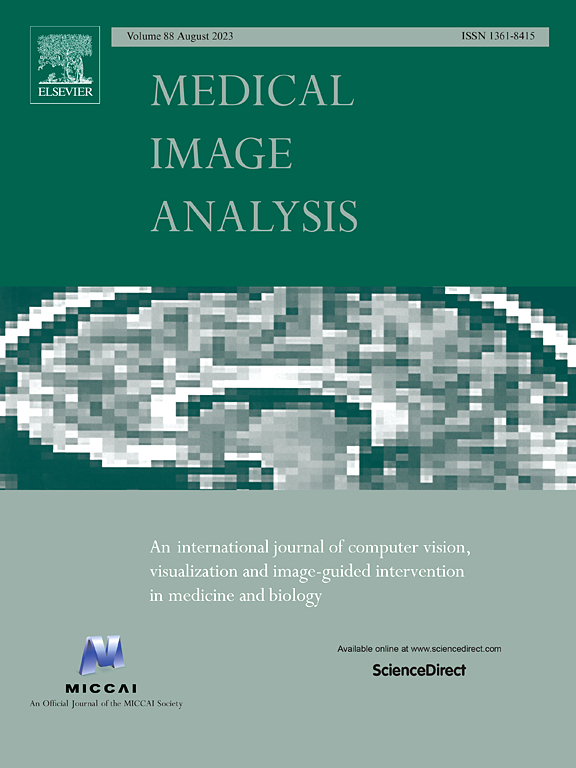用于超分辨率磁共振波谱成像的流式截断去噪扩散模型
IF 10.7
1区 医学
Q1 COMPUTER SCIENCE, ARTIFICIAL INTELLIGENCE
引用次数: 0
摘要
磁共振波谱成像(MRSI)是一种研究新陈代谢的非侵入性成像技术,已成为了解神经系统疾病、癌症和糖尿病的重要工具。要描述病变的特征,需要高空间分辨率的 MRSI,但在实践中,由于代谢物浓度低造成的时间和灵敏度限制,MRSI 的采集分辨率较低。因此,亟需一种后处理方法,从低分辨率数据中生成高分辨率的 MRSI,并能快速、高灵敏度地获取。基于深度学习的超分辨率方法为提高 MRSI 的空间分辨率提供了可喜的成果,但它们生成精确和高质量图像的能力仍然有限。最近,扩散模型在各种任务中都表现出了优于其他生成模型的学习能力,但从扩散模型采样需要迭代大量的扩散步骤,非常耗时。这项工作为超分辨率 MRSI 引入了基于流的截断去噪扩散模型(FTDDM),该模型通过截断扩散链来缩短扩散过程,截断的步骤使用基于流的归一化网络进行估算。该网络以上调因子为条件,以实现多尺度超分辨率。为了训练和评估深度学习模型,我们开发了一个 1H-MRSI 数据集,该数据集来自 25 名高级别胶质瘤患者。我们证明,FTDDM 优于现有的生成模型,同时与基线扩散模型相比,采样过程的速度提高了 9 倍以上。神经放射科医生的评估证实了我们方法的临床优势,该方法还支持不确定性估计和锐度调整,从而扩展了其潜在的临床应用。本文章由计算机程序翻译,如有差异,请以英文原文为准。

A Flow-based Truncated Denoising Diffusion Model for super-resolution Magnetic Resonance Spectroscopic Imaging
Magnetic Resonance Spectroscopic Imaging (MRSI) is a non-invasive imaging technique for studying metabolism and has become a crucial tool for understanding neurological diseases, cancers and diabetes. High spatial resolution MRSI is needed to characterize lesions, but in practice MRSI is acquired at low resolution due to time and sensitivity restrictions caused by the low metabolite concentrations. Therefore, there is an imperative need for a post-processing approach to generate high-resolution MRSI from low-resolution data that can be acquired fast and with high sensitivity. Deep learning-based super-resolution methods provided promising results for improving the spatial resolution of MRSI, but they still have limited capability to generate accurate and high-quality images. Recently, diffusion models have demonstrated superior learning capability than other generative models in various tasks, but sampling from diffusion models requires iterating through a large number of diffusion steps, which is time-consuming. This work introduces a Flow-based Truncated Denoising Diffusion Model (FTDDM) for super-resolution MRSI, which shortens the diffusion process by truncating the diffusion chain, and the truncated steps are estimated using a normalizing flow-based network. The network is conditioned on upscaling factors to enable multi-scale super-resolution. To train and evaluate the deep learning models, we developed a 1H-MRSI dataset acquired from 25 high-grade glioma patients. We demonstrate that FTDDM outperforms existing generative models while speeding up the sampling process by over 9-fold compared to the baseline diffusion model. Neuroradiologists’ evaluations confirmed the clinical advantages of our method, which also supports uncertainty estimation and sharpness adjustment, extending its potential clinical applications.
求助全文
通过发布文献求助,成功后即可免费获取论文全文。
去求助
来源期刊

Medical image analysis
工程技术-工程:生物医学
CiteScore
22.10
自引率
6.40%
发文量
309
审稿时长
6.6 months
期刊介绍:
Medical Image Analysis serves as a platform for sharing new research findings in the realm of medical and biological image analysis, with a focus on applications of computer vision, virtual reality, and robotics to biomedical imaging challenges. The journal prioritizes the publication of high-quality, original papers contributing to the fundamental science of processing, analyzing, and utilizing medical and biological images. It welcomes approaches utilizing biomedical image datasets across all spatial scales, from molecular/cellular imaging to tissue/organ imaging.
 求助内容:
求助内容: 应助结果提醒方式:
应助结果提醒方式:


